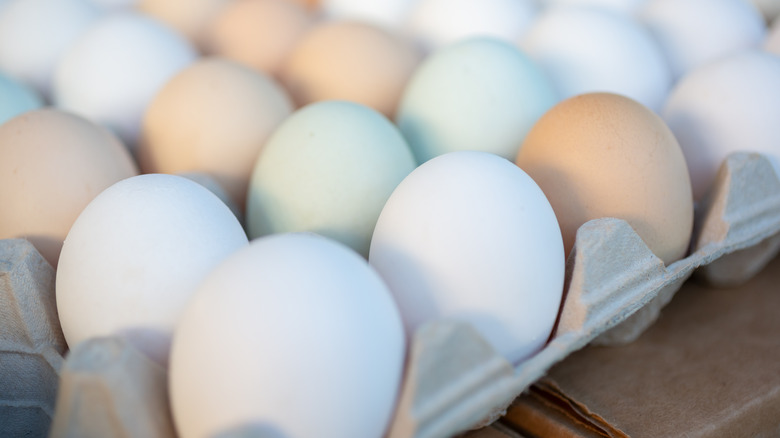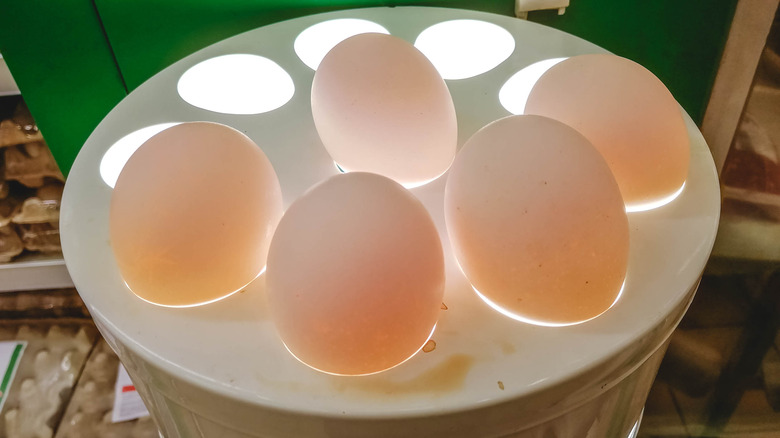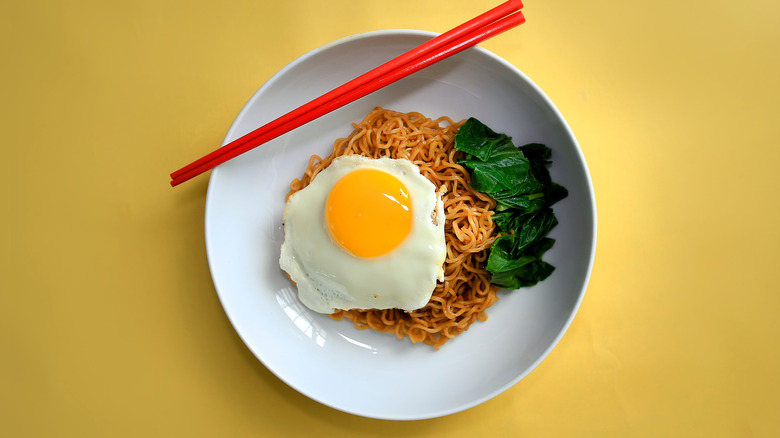What Makes Grade AA Eggs So Much Better Than Grade A
When most people purchase a dozen eggs, they open the carton and give the eggs a once-over to ensure none of them are cracked. Whether they're brown, white, or even blue and green, it's primarily the outer shells that tell us if we'll buy the eggs or not. Some may not even notice that many egg cartons are emblazoned with a grade. Yup, an actual letter grade like we used to get in high school, except egg grades can't get lower than a B (wish we'd been so lucky).
So, what is egg grading? First of all, it's not a requirement. Egg producers have the option to pay for the USDA to inspect their eggs for a grade of AA, A, or B. In a nutshell (or, rather, eggshell), these grades are determined by the quality of the shell and the interior product. They have nothing to do with an egg's nutritional value, size, or safety. The grades you'll see printed on an egg package will be either AA or A, as grade B eggs are typically set aside for liquid and dried egg products. Grade AA eggs are superior eggs, deemed nearly perfect by the USDA and they have the price tag to match such excellence. But that doesn't mean that grade A eggs are not worth purchasing. When it comes down to it, both grades are good for eating, but it's the AAs you might want to splurge on if presentation is high on your priority list.
Making the grade
AA graded eggs will have a smooth, blemish-free shell and a distinct oval shape with one end being a tad larger than the other. The whites are clear and thick in order to hold the yolk firmly in place, and the yolk itself won't have any visible blood spots. How are such things determined without breaking the egg shell? The USDA uses a method called candling which uses a light bright enough to shine right through the shell to determine such factors.
When held up to the light, inspectors will take note of the definition of the yolk. If it's just slightly defined, this means that the white is thick and firm and can be deemed AA if the other factors fit the specifications, too. Air spots will also be looked at. Fresh eggs right from the hen will have very little air pockets in them, but as they cool, the liquid inside contracts, creating an air pocket. AA eggs can have air pockets that are ⅛ inch or less. Since these eggs look the best, they are great choices to use in dishes where the egg is the star of the show, so to speak. Fried eggs, sunny side up eggs, and poached eggs all put the egg on display, so if you're going to spend a few extra dollars on eggs, use the ones at the head of the class.
An A for effort
Just like their "perfect" counterparts, eggs graded with an A rating also have unbroken, smooth shells with an oval shape. Upon candling, A-graded eggs will have yolks that appear very defined, indicating that the whites around them are thinner than AA eggs. As far as the air pocket goes, these eggs' pockets range from ⅛ inch to 3/16 inch. But flavor-wise, nutrition-wise, and the ways they can be cooked, AA and A eggs are exactly the same. Yes, you can poach or fry A-graded eggs, too, as well as scramble, coddle, boil, or bake them into cakes. The best part is, you will pay less for them at the grocery store.
Any eggs that fall short of the stipulations outlined for AA and A grades will be graded with a B, which are still totally fine to eat, but their appearance may not entice people to buy them. All in all, it can be hard to cut through the noise of all of the labels in the egg aisle, but now you know exactly what you're putting on the table.



